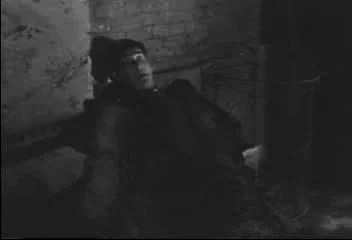Remember how I went to the flicks to see a double feature of science-fiction horror the other day? The follow-up to The Blob was I Married a Monster from Outer Space. You would think that, with a title like that, this was the B-movie stinker of the bunch.
As it turns out, while definitely having a comparatively low budget, in some ways, it is a more chilling and thoughtful film.

In the small town of Morrisville (or Morristown or Morrisburg… something like that), getting hitched is a chore, tantamount to a death sentence. At least, it is to hear the guys tell it. Every night, the fellas go to the local boozery to drown their sorrows and commiserate.

Except for Bill. He's getting married the next day, and he wants to see his lovely bride-to-be.
But then…

An ugly space alien smothers Bill in a cloud, and when next we see him, Bill is a changed man. Faltering, more brutal, his fiancee, Marge, marries him anyway. One year later, an abortive letter from Marge to her mother indicates that she's aware of the change in Bill. Not only is he remote, but animals instinctively dislike him (in one chilling scene, Bill snaps the neck of a dog Marge had given him as an anniversary present). At this point in the film, we're still not sure if Bill has been possessed, if the alien has taken his form, or if Bill is still in there, just a bit altered.
One by one, the men in town are taken. Bill's friends. The local law enforcement.

Bills friend, Sam, adapts to human life with the most gusto, marrying his fiancee, being smarmily sadistic, and otherwise enjoying all of the pleasures existence on Earth has to offer. Except booze. The aliens can't stomach the stuff.
Or, apparently, oxygen. When alien-Sam falls off a rowboat at a park outing, he succumbs when the local doctor gives him pure oxygen to revive him.

Now, through all of this, Marge is the viewpoint character, and this is where the movie is really poignant. She catches on pretty quickly that something is wrong with Bill, and she has a run-in with an undisguised alien fairly early-on. The problem is that no one will believe her. No matter where she turns, whether to the lushes in the bar or her good friend, the chief of police, she is told not to worry her pretty little head. When she tries to phone the FBI, all the lines are down. When she tries to wire the capital, the telegrapher surreptitiously tears up the telegram. In a man's world, when all the men are aliens, who is there for a woman to run to?
Well, I'd sort of hoped that Marge might team up with the other women of the town. After all, the aliens only go after men. Sadly, this never happens, in part because Marge can't get any of the lady-folk to believe her either.

In a very good scene, Marge confronts Alien-Bill, telling him she knows he's an alien. Alien-Bill does not deny it. In fact, Alien-Bill explains the plot: his race fled from a dying world, but all of the females were killed in the flight. They need to inhabit human bodies to mate with human females to make more aliens. Except alien-inhabited people are incapable of mating with human females. Thus, they are trying to genetically modify the females of Morristown/burg/ville to be compatible with the alien males.

What makes this scene so interesting is Alien-Bill's confession that although his motives are selfish, and before he inhabited Bill's body, he had no emotions, Alien-Bill has come to understand and appreciate human feelings. He does not regret his actions, exactly, but he has fallen in love with Marge, and he does not seem to be enjoying is current role. The acting is good enough that Alien-Bill becomes a sympathetic character (despite being rather a bastard).
Ultimately, Marge convinces the town doctor of the truth, and he rounds up a few of the unaffected men to break the alien spaceship. The aliens have ray guns, but the humans have dogs… dogs apparently beat aliens with ray guns.

Once inside the ship, the men discover that all of the possessed males are actually still alive, their bodies in some kind of stasis. They disconnect the apparatus, whereupon the aliens turn into applesauce and die. Happy ending.

Taken as a commentary on the plight of the modern woman, this movie really packs a wallop. How many women have felt trapped and helpless in a marriage with a man who turned out to be a jerk? How often have women's reports of abuse been ignored with a dismissive chuckle? The aliens aren't really so alien, are they?
P.S. Fair warning: Work has been a bear, and my hands can only take so much. I don't want to go to a every-three-days schedule because I have too much to say. Just be aware it may not always be every other day. Thanks for your understanding and your patronage!
(Confused? Click here for an explanation as to what's really going on)
This entry was originally posted at Dreamwidth, where it has comments. Please comment here or there.

























